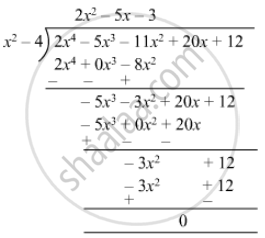Advertisements
Advertisements
Question
Obtain all the zeroes of the polynomial 2x4 − 5x3 − 11x2 + 20x + 12 when 2 and − 2 are two zeroes of the above polynomial.
Solution
We know that if x = α is a zero of a polynomial, and then x - α is a factor of f(x).
Since 2 and −2 are zeros of f(x).
Therefore
(x − 2)(x + 2) = x2−4
(x2 − 4) is a factor of f(x).
Now, we divide 2x4 − 5x3 − 11x2 + 20x +12 by g(x) = (x2 − 4) to find the zero f(x).
By using division algorithm we have f(x) = g(x) x q(x) - r(x)
2x4 − 5x3 − 11x2 + 20x + 12 = (x2 − 4)(2x2 − 5x − 3)
=(x − 2)(x + 2)[2x(x − 3) + 1(x − 3)]
=(x − 2)(x + 2)(x − 3)(2x + 1)
Hence, the zeros of the given polynomial are 2, −2, 3, `−1/2`.
APPEARS IN
RELATED QUESTIONS
Define the zero of a polynomial.
If the sum of the zeros of the quadratic polynomial f(x) = kx2 − 3x + 5 is 1, write the value of k.
If 1 is a zero of the polynomial p(x) = ax2 − 3(a − 1) x − 1, then find the value of a.
If α, β are the zeros of the polynomial f(x) = x2 + x + 1, then \[\frac{1}{\alpha} + \frac{1}{\beta} =\]
If the product of zeros of the polynomial f(x) ax3 − 6x2 + 11x − 6 is 4, then a =
State whether the given algebraic expression is polynomial? Justify.
10
Divide. Write the quotient and the remainder.
(5x3 − 3x2) ÷ x2
Given that two of the zeroes of the cubic poly-nomial ax3 + bx2 + cx + d are 0, the third zero is ______.
The below picture are few natural examples of parabolic shape which is represented by a quadratic polynomial. A parabolic arch is an arch in the shape of a parabola. In structures, their curve represents an efficient method of load, and so can be found in bridges and in architecture in a variety of forms.




If the roots of the quadratic polynomial are equal, where the discriminant D = d2 – 4ac, then:
Classify the following as a constant, linear, quadratic and cubic polynomials:
3
